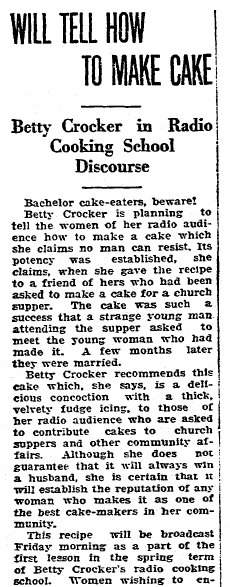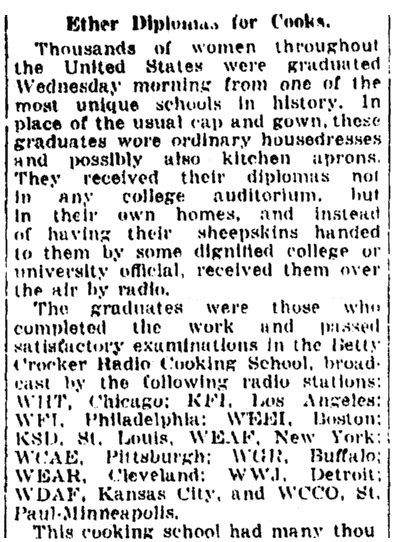Introduction: Gena Philibert-Ortega is a genealogist and author of the book “From the Family Kitchen.” In this blog article, Gena searches old newspapers to learn more about an icon in American cooking: Betty Crocker.
Betty Crocker is a household name that almost everyone in America is familiar with. But do you know who the real Betty Crocker actually is? While her name is attached to a very “real” image of a woman, she – like many other famous food icons – is not a real person, but instead a marketing tool used to sell food products and recipes, and to instill trust in her brand.
How did Betty Crocker come to be such a famous brand? Well, according to author Susan Marks’ book Finding Betty Crocker: The Secret Life of America’s First Lady of Food, it started with letters sent to the Gold Medal Flour Company. Homemakers would write cooking questions to the company and they in turn would send replies they gathered from their Home Service staff. While the advertising department, staffed by men, sent out the answers to these recipe-related questions, the department’s manager didn’t think women would take cooking advice in a letter signed by a man. Because they didn’t necessarily need a woman to fill a new job, they invented a fictional female character. They provided her with a name, asked current female staff to participate in a contest for the best signature, and Betty Crocker was “born.”*
So what year was Betty born? It might surprise you that she actually predates the 1950s, the decade that most people associate her with. She first appeared in a much earlier decade, the 1920s.
So you’re most likely familiar with products that carry the Betty Crocker image and red spoon logo, but how has “she” influenced American cooking over the years? Aside from answering consumers’ letters, she has been the star of her own radio show, shared recipes, and published numerous cookbooks during her long tenure.
Betty Crocker on the Radio
In the days prior to television – and with the advent of cable channels dedicated to food matters way in the future – Betty Crocker hit the air waves. She brought her cooking advice to the masses by presenting programs on the radio. The actress who portrayed Betty not only provided help to her listeners, she used the advice of older homemakers to pass along cooking tips to her audience.
According to this 1929 newspaper article, the “recipe exchange” was a feature of the Betty Crocker radio broadcast that included readers’ tips and recipes.

She not only presented a cooking show, but she conducted a “cooking school” on air. Listeners could “graduate” via Betty Crocker’s radio show. Those who actively participated in all eight cooking lessons would receive a Gold Medal Radio Cooking School diploma at its conclusion. According to this 1926 newspaper article, the “cooking school had many thousands of members all over the United States, ranging in age from 14 to 90 years.” Women could enroll in the school for no fee. Their graduation was a matter of preparing and reporting on recipes. One of the graduates, an 80-year-old woman, had written to Betty Crocker “…and pleaded that she please be allowed to graduate as she had tried so hard and she had never been graduated from anything before in her life.” Like the other culinary students, her diploma was announced over the radio waves.

Betty Crocker Recipes
Newspapers are a source for all kinds of recipes: those written by newspaper staff, submitted by readers, and found in advertisements. Betty Crocker recipes are no exception and can be found throughout the decades in historical newspapers.
[search_box]
Women who listened to Betty Crocker’s radio show were able to add many new recipes to their repertoire. This one from 1928 is for Chocolate Pinwheel Cookies. To show how fool-proof the dessert recipe was, the text exclaims: “Of 278 women trying the recipe, not a single one failed her first attempt!”
During World War II various foods, including meat, were rationed. Betty Crocker recipes addressed those on the home front who needed to feed their families with reduced quantities or food substitutions. In this 1944 advertisement featuring a recipe for Yorkshire Pudding (or “Pig in a Poke”), the text of the advertisement for Gold Medal Flour states: “Betty Crocker offers this ‘meat-extender’ recipe to show you one way Gold Medal ‘Kitchen-tested’ Enriched Flour can add nourishment to your wartime meals.” An image on the lower left reminds consumers that food was integral to the war effort, stating “Food Fights for Freedom” and reminding them to “produce and conserve/share and play square.”
Betty Crocker recipes were meant to help sell various food-related products. A great marketing tool, they demonstrated how to take Betty Crocker cake mixes and turn the finished product into something special for your family to feast on. Consider this 1960 advertisement that utilizes Country Kitchen cake mixes and transforms them into desserts like Spumoni Cake, Hawaiian Velvet Cake, and Colonial Butter-Nut Cake.
Betty Crocker Cookbooks
Many family historians most likely either have a Betty Crocker cookbook or remember one in their family’s collection.
Today we can download the Betty Crocker Cookbook app, but our elders were able to peruse Betty’s recipes in her cookbooks, such as Betty Crocker’s Picture Cook Book which was first published in 1950.
One of the benefits of this cookbook is the fact that it is published as a 3-ring binder which allows its owner to add additional recipes. This 1950 review of the cookbook exclaims: “One of its chief values is that it is looseleaf, enabling the housewife to add clippings from other sources.” The review goes on to explain that the photos and illustrations are helpful aids in preparing the recipes.
The Betty Crocker’s Picture Cook Book now referred to as the Betty Crocker Cookbook, is one of 250 cookbooks since 1950 that sport the Betty Crocker name.**
What are your memories of cooking with Betty Crocker? Do you own the Betty Crocker’s Picture Cook Book? Has your grandma passed down her Betty Crocker diploma? Share your memories in the comments below.
—————————
* Marks, Susan. Finding Betty Crocker: The secret Life of America’s First Lady of Food. Minneapolis, MC: University of Minnesota Press, 2005. Page 10-11.
** “The Story of Betty Crocker.” http://www.bettycrocker.com/menus-holidays-parties/mhplibrary/parties-and-get-togethers/vintage-betty/the-story-of-betty-crocker. Accessed 16 June 2015.
Share Your Recipes with Us!
GenealogyBank has a shared group Pinterest board where you can share your old family recipes. If you have a family recipe you’d like to share, send us a Pinterest group board request and you can pin your recipe on our board to share with the community.
Related Food & Cooking Articles and Resources:
- My Ancestor’s Menu: Researching Food History in Newspapers
- The Real Duncan Hines—The Man, Not the Cake Mix
- The First Foodie: Clementine Paddleford
- Find Grandma’s Recipes in Old Newspaper Food Columns
- Old Fashioned Family Recipes (GenealogyBank Pinterest Board)
[bottom_post_ad]